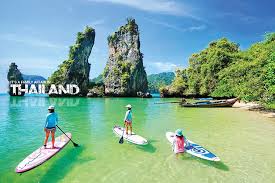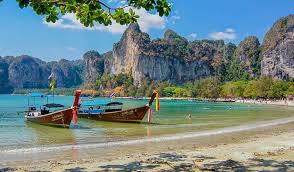Thailand is one of the most affordable and tourist-friendly destinations in Asia. With beautiful beaches, vibrant nightlife, amazing street food, and rich culture — you can easily explore Thailand even if you are on a tight budget. In this complete Thailand Budget Travel guide, you will learn how to plan a perfect, cost-effective Thailand trip without compromising on fun.
Why Choose Thailand for Budget Travel?
Thailand offers the perfect balance of affordability and quality. You get:
- Cheap and comfortable hotels
- Delicious street food at very low prices
- Affordable transportation
- Lots of free or low-cost tourist attractions
This makes Thailand a great choice for backpackers, students, and anyone planning a Thailand budget travel adventure.
1. Choose the Right Time to Travel
Traveling during the right season can save you a lot of money.
Best Low-Budget Seasons:
- May to October (Monsoon Season) – Cheapest flights & hotels
- November to early December – Good weather + moderate prices
Avoid peak season (December 20 – January 10) if you want a true budget trip.
2. Find Cheap Flights to Thailand
Air ticket cost is usually the biggest expense.
Tips to get cheaper flights:
- Book 6–8 weeks earlier
- Use fare comparison sites like Skyscanner or Google Flights
- Travel from Dhaka, Kolkata, or Kuala Lumpur for cheaper options
- Choose weekdays (Tue–Thu) for lower fares
- Pick Don Mueang Airport (DMK) instead of Suvarnabhumi (BKK) for budget airlines
Budget flight cost to Thailand ranges: $120–$250 depending on season and departure point.
3. Budget-Friendly Accommodation in Thailand
Thailand has a wide range of affordable stays:
Best Budget Areas
- Bangkok: Khao San Road, Pratunam
- Pattaya: South Pattaya, Beach Road (2nd road area)
- Phuket: Patong (budget hostels), Kata & Karon
- Chiang Mai: Old City
Budget Price Range
- Hostel bed: $5–$12/night
- Budget hotel: $15–$25/night
- Mid-range hotel: $25–$40/night
Use booking sites such as Booking.com, Agoda, or Airbnb for deals.
4. How to Travel Inside Thailand on a Low Budget
Affordable Transport Options
- BTS Skytrain (Bangkok): Cheap & fast
- Local buses: Very low cost
- Tuk-tuks: Negotiate before entering
- Bike rental: Only $6–$10/day
- Ferry & speedboats: Affordable for island trips
- Grab Taxi: Best for safe and transparent pricing
If your goal is Thailand Budget Travel, avoid unnecessary taxis and local tourist traps that charge higher fares.
5. Eat Delicious Thai Food on a Budget
Thai street food is world famous — delicious, fast, and cheap.
Best Budget Foods
- Pad Thai – $1.50
- Fried Rice – $1–$2
- Papaya Salad – $1
- Mango Sticky Rice – $1.50–$2
- Chicken BBQ – $1
Avoid fancy restaurants; street food gives you original taste and helps you save money.
6. Affordable Places to Visit in Thailand
Bangkok
- Grand Palace (Entry: $15)
- Wat Pho Temple
- Wat Arun
- Chatuchak Market
- Asiatique Riverfront
Pattaya
- Walking Street (Free)
- Pattaya Beach
- Jomtien Beach
- Sanctuary of Truth (Entry: $15)
- Buddha Hill (Free)
Phuket
- Patong Beach (Free)
- Big Buddha (Free)
- Kata & Karon Beach
- Night Markets
Chiang Mai
- Doi Suthep Temple
- Elephant Nature Park (Budget packages available)
- Old City Temples
Most temples and beaches are free, making them perfect for Thailand Budget Travel.
7. How Much Does a Low-Budget Thailand Trip Cost?
Here is a sample 5-day budget travel cost breakdown:
| Expense | Cost |
|---|---|
| Flight | $150–$220 |
| Hotel | $20 × 4 nights = $80 |
| Food | $10/day × 5 = $50 |
| Transport | $30 |
| Activities | $40 |
| Total | $350–$420 only |
You can reduce cost even further by choosing hostels and local buses.
8. Smart Money-Saving Tips
- Always buy a local SIM for cheap internet
- Use Grab to avoid being overcharged
- Eat from street food stalls
- Avoid tourist scams
- Use local ferries instead of private boats
- Don’t shop from airport — very expensive
- Book all tickets online to get discounts
Final Thoughts
Planning a Thailand trip on a low budget is easier than you think. With smart planning, choosing the right season, using local transport, and focusing on affordable foods and hotels — you can enjoy a full travel experience without spending a lot.
Whether you love beaches, temples, nightlife, or culture, Thailand has something for every traveler. This Thailand Budget Travel guide will help you plan a perfect, cost-saving, and memorable trip.
FAQ
1. How much money do I need for a budget trip to Thailand?
A 5–7 day budget trip typically costs $350–$500, including flight, hotel, food, and local transport.
2. What is the cheapest time to visit Thailand?
The cheapest season is May to October (monsoon months). Flights and hotels are much cheaper during this time.
3. Is Thailand safe for budget travelers?
Yes, Thailand is very safe for tourists. Just avoid scams, negotiate prices, and use Grab for taxis.
4. What are the best budget places to stay in Thailand?
Popular budget-friendly areas include Khao San Road (Bangkok), Pratunam, Patong (Phuket), Jomtien (Pattaya), and Old City (Chiang Mai).
5. How can I save money on food in Thailand?
Eat at street food stalls, local markets, and night markets. Meals cost $1–$2 only.
6. What is the cheapest transport option inside Thailand?
Use BTS Skytrain, local buses, shared taxis, or motorbike rentals to travel at a low cost.
7. Do I need a visa to travel to Thailand from Bangladesh?
Bangladeshi citizens need a tourist visa, which can be done through the Thai Embassy or visa centers.
8. Are Thailand tourist attractions expensive?
Most attractions like beaches and temples are free. Popular paid spots cost between $5–$15.
9. Can I travel Thailand on a very tight budget as a student?
Yes! Thailand is one of the best countries for budget backpackers and students. Hostels cost just $5–$10 per night.
10. How can I avoid overspending on a Thailand trip?
Plan ahead, use local transport, avoid tourist traps, eat local food, book hotels early, and compare prices online.


